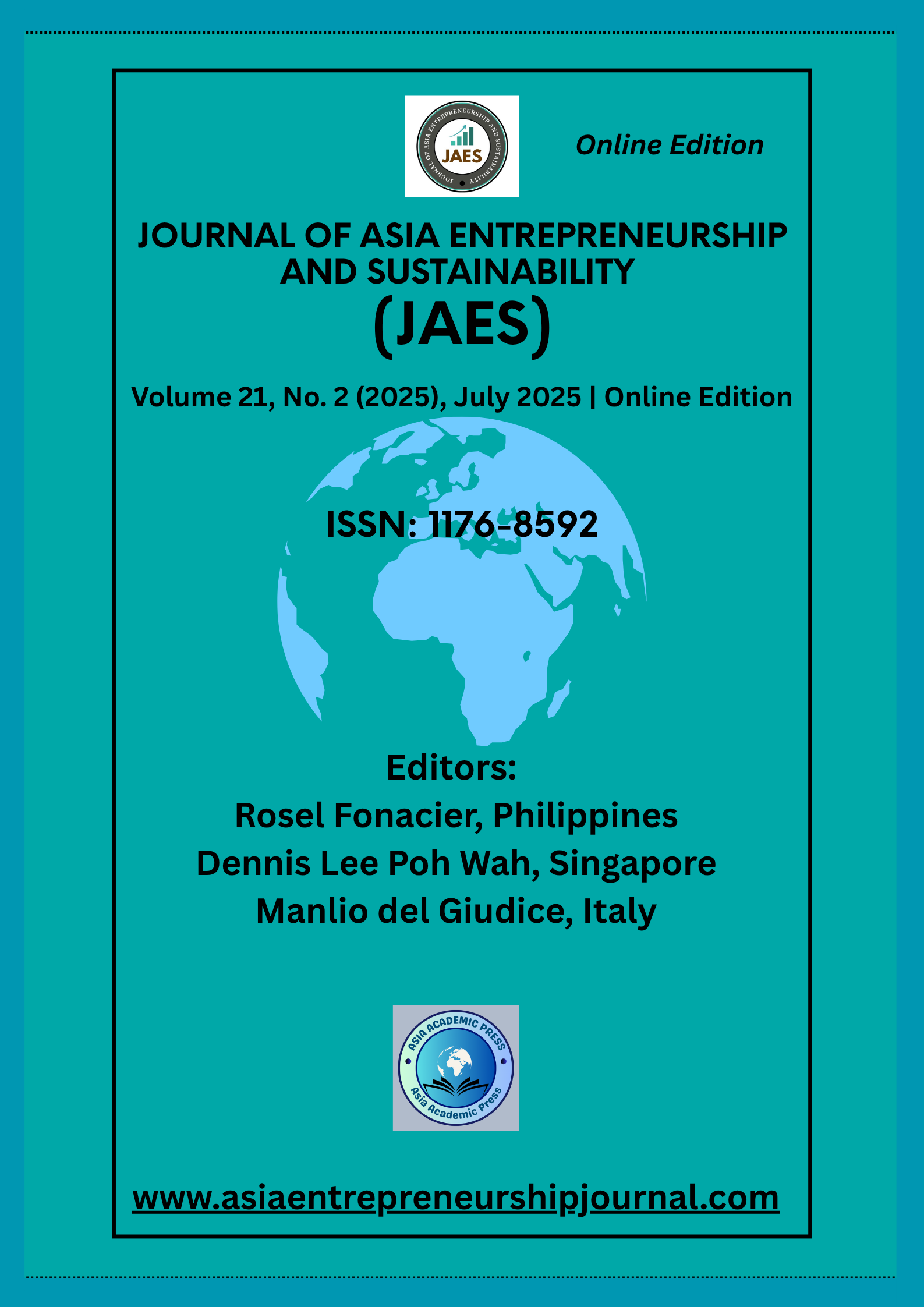Tourism Informatics for Environmental Sustainability: Current Landscape and Future Directions
DOI:
https://doi.org/10.53555/jaes.v21i2.17Keywords:
Tourism Informatics, Sustainable Tourism, Environmental Sustainability, Information and Communication Technology (ICT), Geographic Information Systems (GIS), Big Data Analytics.Abstract
The union of technology and tourism has given birth to the field of tourism informatics, which is the application of Information and Communication Technology (ICT) to support, enhance, and manage tourist activities. Due to increasing pressures over the degradation of the environment as a result of uncontrolled tourism, the application of tourism informatics in enabling environmentally sustainable practices has become increasingly important. This research paper endeavours to delve into the current state of tourism informatics in facilitating environmentally sustainable tourism, with a specific focus on tools such as Geographic Information Systems (GIS), mobile applications, smart tourism systems, and big data analysis. The study will identify ways through which these technology-based innovations are contributing to the efficiency of the use of resources, disposal of wastes, visitor management, and raising eco-awareness, and ascertain weaknesses and limitations of such applications. Drawing from cross-cutting studies worldwide and sharing examples of case studies from selected world regions, the paper will critique both opportunities and drawbacks to promoting an appropriate equilibrium between tourism’s progress and conservation efforts through tourism informatics.
References
1. Baggio, R. (2011). ICT and tourism: A complex perspective. In L. Cantoni & Z. Xiang (Eds.), Information and Communication Technologies in Tourism 2011 (pp. 3–12). Springer. https://doi.org/10.1007/978-3-7091-0503-0_1
2. Becken, S. (2019). Sustainable tourism and digital transformation: Challenges and opportunities. Journal of Sustainable Tourism, 27(1), 1–17. https://doi.org/10.1080/09669582.2019.1588281
3. Becken, S. (2017). Sustainable tourism and its use of information and communication technologies (ICTs). In M. Sigala & U. Gretzel (Eds.), Advances in Social Media for Travel, Tourism and Hospitality (pp. 125–139). Routledge.
4. Bhattacharya, R., & Dey, S. (2021). Digital transition in Indian tourism: Challenges and opportunities for sustainable development. Tourism Recreation Research, 46(3), 327–341. https://doi.org/10.1080/02508281.2020.1846972
5. Bibri, S. E., & Krogstie, J. (2017). Smart sustainable cities of the future: An extensive interdisciplinary literature review. Sustainable Cities and Society, 31, 183–212. https://doi.org/10.1016/j.scs.2017.02.016
6. Boes, K., Buhalis, D., & Inversini, A. (2016). Smart tourism destinations: Ecosystems for tourism destination competitiveness. International Journal of Tourism Cities, 2(2), 108–124. https://doi.org/10.1108/IJTC-12-2015-0032
7. Brundtland Commission. (1987). Our Common Future. Oxford University Press.
8. Buhalis, D., & Amaranggana, A. (2015). Smart tourism destinations enhancing tourism experience through personalization of services. Information and Communication Technologies in Tourism 2015, 377–389. https://doi.org/10.1007/978-3-319-14343-9_28
9. Buhalis, D., & Sinarta, Y. (2019). Real-time co-creation and nowness service: Lessons from tourism and hospitality. Journal of Travel & Tourism Marketing, 36(5), 563–582. https://doi.org/10.1080/10548408.2019.1618781
10. Elkington, J. (1999). Cannibals with forks: The triple bottom line of 21st century business. Capstone.
11. Gössling, S. (2021). Digitalization, resilience and sustainability in tourism: A critical perspective. Journal of Sustainable Tourism, 29(11–12), 1839–1855. https://doi.org/10.1080/09669582.2021.1878264
12. Gössling, S. (2002). Global environmental consequences of tourism. Global Environmental Change, 12(4), 283–302. https://doi.org/10.1016/S0959-3780(02)00044-4
13. Gössling, S., & Hall, C. M. (2006). Tourism and global environmental change: Ecological, social, economic and political interrelationships. Routledge.
14. Gössling, S., Peeters, P., Hall, C. M., Ceron, J. P., Dubois, G., Lehmann, L. V., & Scott, D. (2012). Tourism and water use: Supply, demand, and security. An international review. Tourism Management, 33(1), 1–15. https://doi.org/10.1016/j.tourman.2011.03.015
15. Gretzel, U., Sigala, M., Xiang, Z., & Koo, C. (2015). Smart tourism: Foundations and developments. Electronic Markets, 25(3), 179–188. https://doi.org/10.1007/s12525-015-0196-8
16. Indian Council of Social Science Research (ICSSR). (2018). Ethical guidelines for research in social sciences. New Delhi: ICSSR. https://icssr.org/ethical-guidelines
17. Kerala Department of Tourism. (2017). Kerala tourism policy 2017. Government of Kerala. https://www.keralatourism.org/policy
18. Kerala Responsible Tourism Mission. (2018–2023). Annual reports. Government of Kerala. https://www.keralatourism.org/responsible-tourism/
19. Kerala State IT Mission. (2021). Digital Kerala: Infrastructure and inclusion roadmap. Government of Kerala. https://itmission.kerala.gov.in
20. Kshetri, N. (2021). Blockchain and sustainable tourism: Reducing environmental and social impacts. Tourism Management Perspectives, 39, 100847. https://doi.org/10.1016/j.tmp.2021.100847
21. Latour, B. (2005). Reassembling the social: An introduction to actor-network-theory. Oxford University Press.
22. Lenzen, M., Sun, Y. Y., Faturay, F., Ting, Y. P., Geschke, A., & Malik, A. (2018). The carbon footprint of global tourism. Nature Climate Change, 8(6), 522–528. https://doi.org/10.1038/s41558-018-0141-x
23. Li, Y., Hu, C., Huang, C., & Duan, L. (2018). The concept of smart tourism in the context of tourism informatization. Tourism Management, 58, 293–300. https://doi.org/10.1016/j.tourman.2016.03.014
24. Ministry of Environment, Forest and Climate Change. (2020). Draft national strategy for ecotourism. Government of India. https://moef.gov.in
25. Nair, M., & Sreekumar, T. T. (2020). Smart tourism in Kerala: Mapping infrastructure readiness and policy alignment. Asian Journal of Innovation and Policy, 9(1), 58–73. https://doi.org/10.7545/ajip.2020.9.1.058
26. Navío-Marco, J., Ruiz-Gómez, L. M., & Sevilla-Sevilla, C. (2018). Progress in information technology and tourism management: 30 years on and 20 years after the Internet. Tourism Management, 69, 460–470. https://doi.org/10.1016/j.tourman.2018.06.002
27. Senthilkumar, P., Jeyaraj, R., & Suryanarayana, M. (2021). Climate-tourism analysis using big data and machine learning techniques in Indian coastal regions. Journal of Environmental Informatics, 38(2), 89–101. https://doi.org/10.3808/jei.202100043
28. UNEP. (2022). Climate change and tourism: Impacts and adaptation. United Nations Environment Programme. https://www.unep.org/resources/report/climate-change-and-tourism
29. UNWTO. (2019). Smart tourism: Big data and innovation for sustainable tourism. World Tourism Organization. https://www.e-unwto.org/doi/book/10.18111/9789284420625
30. UNEP. (2019). Tourism and coral reefs: A guide for sustainable practices. United Nations Environment Programme.
31. UNWTO. (2020). International tourism highlights, 2020 edition. World Tourism Organization. https://www.unwto.org/international-tourism-highlights
32. UNWTO. (2005). Making tourism more sustainable: A guide for policy makers. World Tourism Organization and UNEP.R. (2017). Analytics in smart tourism design. In Analytics in Smart Tourism Design (pp. 1–14). Springer.
33. Yung, R., & Khoo-Lattimore, C. (2019). New realities: A systematic literature review on virtual reality and augmented reality in tourism research. Current Issues in Tourism, 22(17), 2056–2081. https://doi.org/10.1080/13683500.2017.1417359









